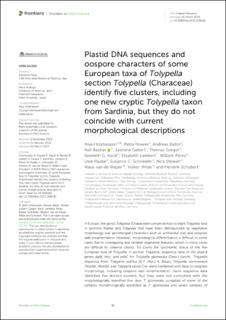| dc.contributor.author | Holzhausen, Anja | |
| dc.contributor.author | Nowak, Petra | |
| dc.contributor.author | Ballot, Andreas | |
| dc.contributor.author | Becker, Ralf | |
| dc.contributor.author | Gebert, Jasmina | |
| dc.contributor.author | Gregor, Thomas | |
| dc.contributor.author | Karol, Kenneth G. | |
| dc.contributor.author | Raabe, Uwe | |
| dc.contributor.author | Schneider, Susanne Claudia | |
| dc.contributor.author | Stewart, Nick | |
| dc.contributor.author | Van de Weyer, Klaus | |
| dc.contributor.author | Wilde, Volker | |
| dc.contributor.author | Schubert, Hendrik | |
| dc.date.accessioned | 2023-09-21T13:04:21Z | |
| dc.date.available | 2023-09-21T13:04:21Z | |
| dc.date.created | 2023-03-03T12:44:21Z | |
| dc.date.issued | 2023 | |
| dc.identifier.citation | Frontiers in Plant Science. 2023, 14, 1-13, 1096181 | en_US |
| dc.identifier.issn | 1664-462X | |
| dc.identifier.uri | https://hdl.handle.net/11250/3091108 | |
| dc.description.abstract | In Europe, the genus Tolypella (Characeae) comprises four to eight Tolypella taxa in sections Rothia and Tolypella that have been distinguished by vegetative morphology and gametangial characters such as antheridial size and oospore wall ornamentation. However, morphological differentiation is difficult in some cases due to overlapping and variable vegetative features, which in many cases are difficult to observe clearly. To clarify the taxonomic status of the five European taxa of Tolypella in section Tolypella, sequence data of the plastid genes atpB, rbcL and psbC for Tolypella glomerata (Desv.) Leonh., Tolypella hispanica Allen, Tolypella nidifica (O.F. Müll.) A. Braun, Tolypella normaniana (Nordst.) Nordst. and Tolypella salina Cor. were combined with data on oospore morphology, including oospore wall ornamentation. Gene sequence data identified five distinct clusters, but they were not consistent with the morphologically identified five taxa. T. glomerata consisted of some of the samples morphologically identified as T. glomerata and seven samples of T. normaniana, while the remaining T. glomerata samples clustered with specimens of unclear affiliation (Tolypella sp.). We identified two clusters of T. hispanica within the European material: cluster T. hispanica I consisted of samples from various locations, whereas the second cluster (T. hispanica II) consisted of samples of T. hispanica from Sardinia Island. The remaining cluster consisted of all the specimens that had been determined as T. salina or T. nidifica in addition to two specimens of T. normaniana. Oospore morphology was most clearly distinguishable for T. glomerata. Oospore characteristics for all other taxa were not as informative but showed some geographical and/or environmentally influenced differences, especially for T. nidifica and T. salina. Our results suggest the need to further check the different taxonomy of Tolypella sect. Tolypella in which specimens normally identified as T. glomerata might be two different taxa, T. glomerata and an unidentified taxon; T. nidifica and T. salina are not separate taxa; T. normaniana is a diminutive variant of two different Tolypella taxa; and T. hispanica comprises two different taxa, one from the Mediterranean island Sardinia. | en_US |
| dc.language.iso | eng | en_US |
| dc.publisher | Frontiers | en_US |
| dc.rights | Navngivelse 4.0 Internasjonal | * |
| dc.rights.uri | http://creativecommons.org/licenses/by/4.0/deed.no | * |
| dc.title | Plastid DNA sequences and oospore characters of some European taxa of Tolypella section Tolypella (Characeae) identify five clusters, including one new cryptic Tolypella taxon from Sardinia, but they do not coincide with current morphological descriptions | en_US |
| dc.type | Peer reviewed | en_US |
| dc.type | Journal article | en_US |
| dc.description.version | publishedVersion | en_US |
| dc.rights.holder | © 2023 The Authors | en_US |
| dc.source.pagenumber | 1-13 | en_US |
| dc.source.volume | 14 | en_US |
| dc.source.journal | Frontiers in Plant Science | en_US |
| dc.identifier.doi | 10.3389/fpls.2023.1096181 | |
| dc.identifier.cristin | 2131004 | |
| dc.source.articlenumber | 1096181 | en_US |
| cristin.ispublished | true | |
| cristin.fulltext | original | |
| cristin.qualitycode | 2 | |

